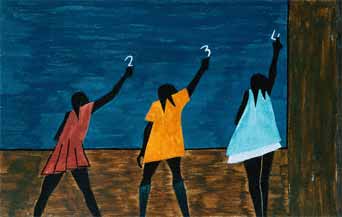|
|
 |
 |
 |

In the North the Negro had better educational
facilities.
The Migration of the Negro, panel
58, 1940-41. Casein tempera on hardboard, 12 x 18 in. (30.5 x 45.7
cm). The Museum of Modern Art, New York; gift of Mrs. David M. Levy
Artwork © Gwendolyn Knight Lawrence, courtesy of the Jacob and
Gwendolyn Lawrence Foundation
Click here to view a larger image |
| |
|
 |
 indicates a link to another site
indicates a link to another site
After  Reconstruction,
southern educational facilities were segregated and schools for blacks
were poorly maintained, meagerly equipped, and overcrowded. In 1916,
The United States Bureau of Education found that annual per capita
spending for education in southern states averaged $10.32 for whites,
but only $2.89 for blacks.1 Reconstruction,
southern educational facilities were segregated and schools for blacks
were poorly maintained, meagerly equipped, and overcrowded. In 1916,
The United States Bureau of Education found that annual per capita
spending for education in southern states averaged $10.32 for whites,
but only $2.89 for blacks.1
Many southern blacks migrated to the North in search of better educational
opportunities for their children. Although the school system in the
North was also segregated, here the schools for blacks had better
equipment and more staff than their southern counterparts. Northern
states also had compulsory education laws, which encouraged students
to stay in school, instead of dropping out and working as southern
blacks often did. Nearly twice as many black students completed high
school in the North than in the South.2
While Lawrence explored the false promises of the North, some of his
Migration Series paintings present the hope for something better:
greater access to education, greater work opportunities, and the freedom
to vote. In this image, Lawrence composed the classroom environment
as a "landscape" where the importance of education and growth,
especially for girls, is emphasized.
1. Carole Marks, Farewell–We're Good
and Gone: The Great Black Migration (Bloomington, Indiana: Indiana
University Press, 1989), p. 145.
2. Spencer Crew, Field to Factory: Afro-American Migration 1915-1940
(Washington, D.C.: National Museum of American History, Smithsonian
Institute, 1987), p. 59. |
|
|

Think about your own classroom and school.
What does your classroom environment or "landscape" look like?
What facilities do you have?
For example: Do you have desks? Blackboards? Computers?
What else do you wish you had? Why?
Why do some schools have more facilities than others?
• Draw three pictures of yourself at different stages of your education.
Do you remember your first day of school? How have you changed since then?
Write captions below your pictures.
• Draw, paint, or photograph an element or detail of your classroom
in a horizontal landscape format. Use this classroom landscape as a background
to put yourself in the picture. If you like, include a couple of your classmates.
|









